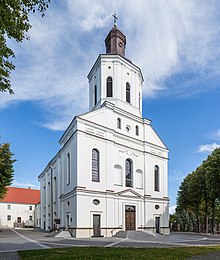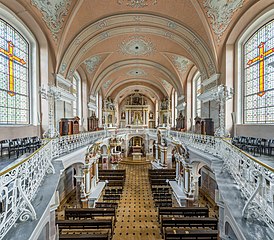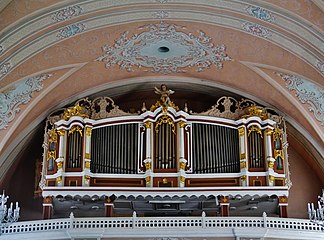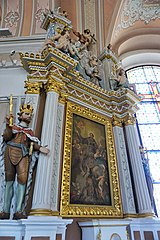| Cathedral of St. Anthony of Padua Šv. Antano Paduviečio katedra | |
|---|---|
 | |
| Religion | |
| Affiliation | Roman Catholic |
| Ecclesiastical or organizational status | Cathedral |
| Year consecrated | 1794 |
| Status | Active |
| Location | |
| Location | Telšiai, Lithuania |
| Geographic coordinates | 55°58′56″N 22°14′47″E / 55.98222°N 22.24639°E / 55.98222; 22.24639 |
| Architecture | |
| Style | Baroque and Classicism |
| Materials | plastered masonry |
The Cathedral of St. Anthony of Padua (Lithuanian: Telšių Šv. Antano Paduviečio katedra) is a Roman Catholic cathedral in Telšiai, Lithuania, seat of the Roman Catholic Diocese of Telšiai.
History

The history of the church dates back to 1624 when Deputy Chancellor of Lithuania Paweł Stefan Sapieha established a Franciscan monastery and built a wooden church on the Insula hill in the centre of Telšiai. A new spacious brick church was constructed between 1762 and 1794. It was consecrated in 1794 by the suffragan bishop of Samogitia, Fr Tadeusz Józef Bukaty (Lithuanian: Tadas Juozapas Bukota).
In 1802 renowned Vilnius architect Jan Boretti obliged to construct two towers and a narthex. However, due to unknown reasons he built only the narthex and failed to complete the work of towers.
Franciscan monastery was dissolved in 1853 by the Russian tsar and the church became parish church. Romualdas Leščevskis became the first secular parish priest in 1854. The tower was built in 1859. In 1893 architect Piotras Serbinovičius designed the fence and gates of the churchyard.
After the establishment of the Roman Catholic Diocese of Telšiai in 1926, the church became a cathedral. Three Bishops of Telšiai, Justinas Staugaitis, Vincentas Borisevičius and Pranciškus Ramanauskas, are buried in the cathedral's tomb. Bishops Petras Maželis, Juozapas Pletkus and Antanas Vaičius are buried in the churchyard.
In 1938 Czech master and organ builder Otto Kratokvil built a modern organ. This large manual and foot-operated Romantic-style organ has 22 registers and is machine-made. The keyboard and mechanical parts were manufactured by various western firms and the wooden pipes were made in Šiauliai.
In order to commemorate the 600th anniversary of baptism of Samogitia, artist Romualdas Inčirauskas decorated the doors of the cathedral with the Samogitian baptism story. The crypt was also reconstructed.
Architecture
The cathedral reflects features of Baroque and Classicism. Its plan is rectangular. It has one tower and a three-wall apse. The cathedral's nave is bordered by two aisles, separated by piers. Two-sloped roof provides the cathedral with slender proportions. It also has a tower above the eastern facade. The exterior of the building is laconic and restrained. The modest width of the side facades is divided by original pairs of windows: smaller oval windows light the lower gallery and the upper part has tall narrow windows. The space between the windows is divided by the pilasters.
The interior of the cathedral is spacious and light. The pillars which support the gallery are modified visually by the arches which link them and surround the chancel. Profiled wall columns, cornices and the installations form an organic part of the interior. Artist Jurgis Mažeika designed two altars beside the pillars and in the presbytery as well as the pulpit while artist Tomasz Podhajski (Lithuanian: Tomas Podgaiskis) designed three altars in the second storey and the central altar.
Telšiai Cathedral is the only church in Lithuania which has a two-storey altar.
The churchyard gates are designed as a tripartite triumphal arch with ornamental decoration: the complex cornices, vaults and niches reflect the harmony of neo-baroque and neo-renaissance forms typical of fin-de-siecle historicism. in 2005 the sculptures of St. Anthony of Padua (patron of the cathedral) and St. Stanislaus (patron of Telšiai city) designed by Arūnas Sakalauskas were constructed to the churchyard gates.
Interior gallery
References
- BUTRIMAS, Adomas (1998). "Telšių buvęs bernardinų vienuolynas ir Šv. Antano Paduviečio bažnyčia". In Rūta Janonienė, Dalia Klajumienė (ed.). Lietuvos vienuolynai. Vadovas. Vilniaus dailės akademija. ISBN 9986-571-39-1.
- BUTRIMAS, Adomas. Telšiai: the Sacral Ensemble on Insula Hill. Vilnius:Vilniaus dailės akademijos leidykla, 2008, p. 49
- BUTRIMAS, Adomas. Telšiai: the Sacral Ensemble on Insula Hill. Vilnius:Vilniaus dailės akademijos leidykla, 2008, p. 115
- BUTRIMAS, Adomas. Telšiai: the Sacral Ensemble on Insula Hill. Vilnius:Vilniaus dailės akademijos leidykla, 2008, p. 95
- ^ "Telšių Šv. Antano Paduviečio katedra". Lithuanian State Department of Tourism. 2004. Retrieved 2012-12-02.
- BUTRIMAS, Adomas. Telšiai: the Sacral Ensemble on Insula Hill. Vilnius:Vilniaus dailės akademijos leidykla, 2008, p. 169
- Lithuania commemorates the 600th anniversary of baptism of Samogitia
- BUTRIMAS, Adomas. Telšiai: the Sacral Ensemble on Insula Hill. Vilnius:Vilniaus dailės akademijos leidykla, 2008, p. 107
- BUTRIMAS, Adomas. Telšiai: the Sacral Ensemble on Insula Hill. Vilnius:Vilniaus dailės akademijos leidykla, 2008, p. 109
- Baroque in Lithuania. Guide by Tojana Račiūnaitė. Baltos lankos, 2007, p. 108
- BUTRIMAS, Adomas. Telšiai: the Sacral Ensemble on Insula Hill. Vilnius:Vilniaus dailės akademijos leidykla, 2008, p. 121
- Meno ženklai
- Roman Catholic cathedrals in Lithuania
- Roman Catholic churches in Telšiai County
- Roman Catholic churches completed in 1794
- Telšiai
- 1624 establishments in Europe
- Objects listed in Lithuanian Registry of Cultural Property
- 18th-century Roman Catholic church buildings in Lithuania
- Neoclassical church buildings in Lithuania
- Saint Anthony of Padua churches






